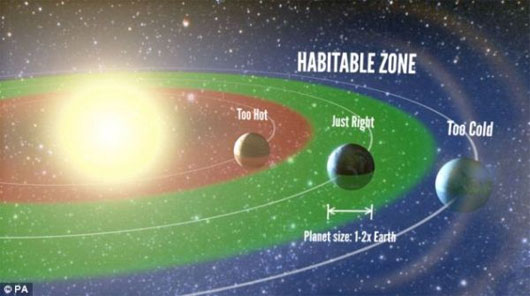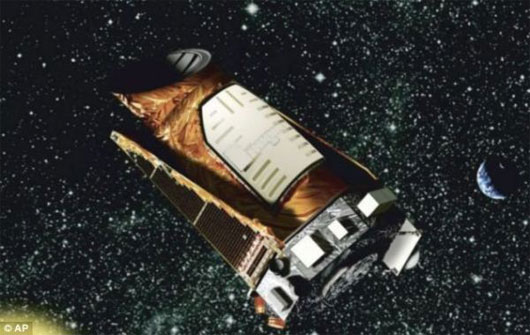40 billion planets can sustain life
After eliminating the gaps in the data, NASA scientists estimate that among planetary systems orbiting stars similar to the Sun, about 22% contain a planet capable of sustaining living. And when counting smaller and darker stars, the number of planets with temperatures allows for the creation of life up to 40 billion planets.
>>>There are "worth living" planets over Earth?

The area with the ability to maintain life (green) is in the middle.The red zone is too hot, while the outer region is too cold to maintain life
For years, scientists have been constantly searching for a planet about the size of the earth and close to us. Appropriate orbits of the planet for stars are called "habitable zones " or " habitable areas".
According to scientists, life-sustaining temperature is the temperature that allows the formation of liquid water and lakes. These planets are located in the life support zone, or "Goldilocks" zone , where the planet's orbit is close enough to the corresponding star to produce a temperature suitable for life, not so hot Burning like many other planets.
In order to find a suitable area to sustain life in each planetary system (including a star / star system and surrounding planets), scientists need to find the level of emissivity of the planet this star Chemical elements play an important role in this search. For example, molecules in the atmosphere can capture a certain amount of energy from starlight and reflect the remaining energy into outer space.
That's why the Kepler satellite was completed in March 2009, at a cost of £ 395 million. Kepler's main purpose is to find planets of the same size as the Earth and capable of sustaining life.

At the end of his four-year mission, Kepler was severely degraded but still accomplished the task excellently.
Kepler uses a method called "moving method" to search for extrasolar planets. A "move" is counted when a planet passes through the corresponding star and telescope. Each move will create a change in the brightness of this star with a duration of 1 to 16 hours.
If the "moves" happen periodically, scientists will find out if the change is caused by a planet. According to them, the moves need to be repeated and have a constant time to confirm that it is a planet.

Kepler has the ability to track 150,000 stars in the Cygnus galaxy
Once a planet has been identified in this way, scientists can calculate the orbital size of the planet based on the time of each cycle. Based on the decrease in brightness due to the star emitting the same size of the star, NASA is able to calculate the size of a planet.
According to a report from Kepler, a research team consisting of many NASA scientists discovered that the galaxy is "full of life". And that's just one of the 40 billion "2nd Earth" in the Milky Way.
Scientists Andrew Howard, of the University of Hawaii, said: "Life-sustaining planets appear a lot in the galaxy. We still don't know how easily life can expand on planets. But with 40 billion opportunities, I am optimistic that people are not alone in the universe. "

Photo of the galactic band captured by Kepler
After eliminating the gaps in the data, the scientists estimated that among the planetary systems orbiting stars similar to the Sun, about 22% contained a sustained planet. life. In the Milky Way galaxy there are about 200 billion stars, so there will be 11 billion planets capable of supporting life.
When counting smaller and darker stars, the number of planets with a temperature allows for the creation of life up to 40 billion planets.
However, it should be noted that not all planets with moderate temperatures can sustain life.

Items in the life-sustaining area: (from left to right) Kepler-22b, Kepler-69c, Kepler-62e, Kepler-62f and Earth
Researchers Geoffrey Marcy at the University of California said: "Some planets may have too thick atmospheres, so that the surface of the soil becomes so hot that DNA-like molecules cannot survive. Others have There can be sufficient convex surface to contain liquid water, suitable for living organisms ".
He added: "The main purpose of the Kepler mission is to answer the question: when you look at the night sky, what percentage of the stars do you see has a planet the size of Earth? turning around, and having enough temperature to keep the water from freezing or vaporizing, but to be kept in liquid form, while liquid water is a prerequisite for producing life ".
However, Dr. Subhanjoy Mohanty, an astrophysicist at the University of the United Kingdom, said that the study showed that "the possibility that we are not alone in the universe is much larger than previously thought. ".
"This is a new impetus for future missions to study the atmosphere of these planets, allowing us to find out if they are truly capable of sustaining life, and whether whether these atmospheres show the true biological traces of life, " said Dr. Subhanjoy Mohanty.
- 60 billion planets can support life
- 100 billion planets reside in the Milky Way
- There are at least 50 billion planets in the Milky Way
- The Milky Way might contain 10 billion Earth-like planets
- Hawking: 'Don't approach aliens anymore, before it's too late.'
- 100 billion planets in the Milky Way
- There are billions of planets like Earth
- Detecting planets can live near Earth
- Is there life on Venus?
- Discover more than 700 planets outside the solar system
- The Milky Way has billions of planets close to Earth
- Kepler discovered 20 Earth-like planets that could contain life
 Van Allen's belt and evidence that the Apollo 11 mission to the Moon was myth
Van Allen's belt and evidence that the Apollo 11 mission to the Moon was myth The levels of civilization in the universe (Kardashev scale)
The levels of civilization in the universe (Kardashev scale) Today Mars, the sun and the Earth are aligned
Today Mars, the sun and the Earth are aligned The Amazon owner announced a secret plan to build a space base for thousands of people
The Amazon owner announced a secret plan to build a space base for thousands of people